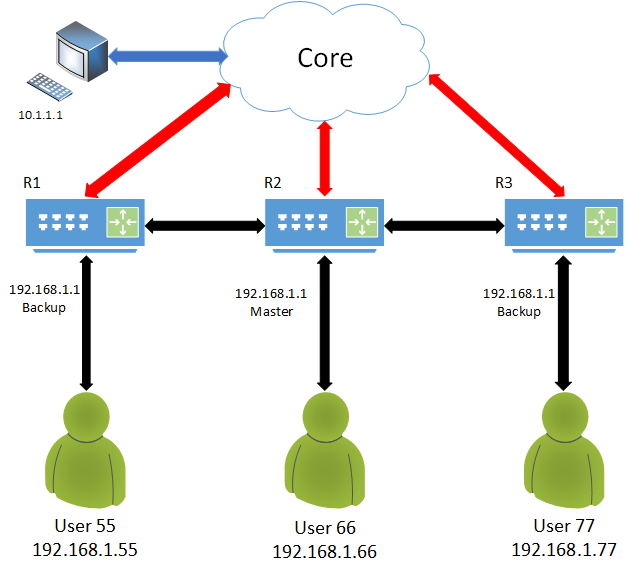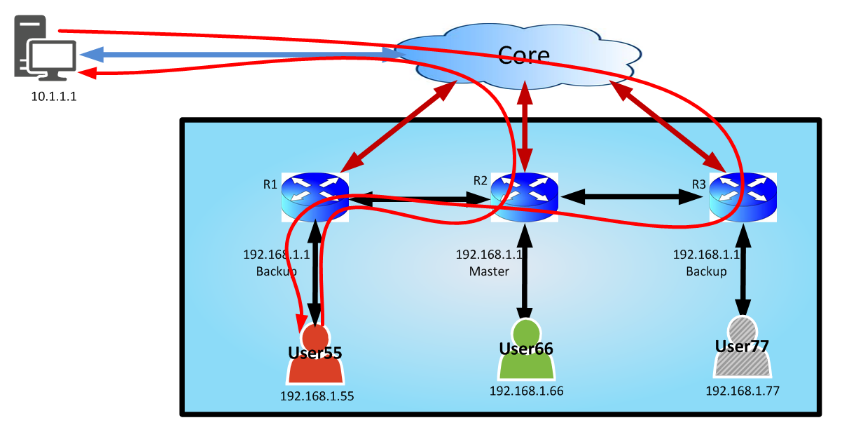VRRP (Virtual Router Redundancy Protocol) host mobility solves the asymmetric routing problem associated with VRRP where the path to return to an end host may be different and longer than necessary.This feature uses host routes to indicate where in the network an end host resides. Using other routing protocols such as OSPF (Open Shortest Path First), other routers will them pick the shortest path back to the end host when multiple paths are available via ECMP (Equal Cost Multi Paths) route entries.

R1, R2, and R3 all advertise 192.168.1.0/24 to the core. This means that return traffic to the users will be sent from the core to any of these routers. A non-optimal path for the flows in either direction may result. Flows from User 55 to Core would traverse R1, R2. The return path could traverse R3, R2, and R1.

Fabric Routing solves part of this path problem by allowing the backup routers to forward frames for the clients without having to send the frame to the master router for the group. Now frames from User 55 will be routed by the first router that receives the frame (R1). Unfortunately, the return path to User 55 from the core is still via Equal Cost Multipath (ECMP) to any of the routers. Again, the frame may have to still traverse R3, R2, and finally R1 to reach User 55 from the core.
The host mobility feature uses ARP/ND to learn each user connected to the IP Network on the router that is closest to the end host. It then uses routing protocols such as OSPF to advertise the hosts IP/IPv6 address. These “Host Routes” will be advertised to other routers making them the preferred route to the end host‘s IP address. As the host route propagates through the network the most efficient path to the end host will be revealed as every other path will have an additional cost. With host mobility, User 55‘s complete route will be advertised to R2, R3 and the core. The core will then receive a route to User 55‘s address from all three routers. The most direct route will have less hops and a lower cost than the routes reported by R2 and R3. When traffic destined to User 55 enters the core the most direct path (R1) is selected.
The ExtremeXOS Host-Mobility feature is implemented using the user space application VRRP, which listens for ARP/ND updates from the kernel using the FDB (forwarding database). When ARP/ND entries are inserted into the kernel, the FDB notifies the host-mobility application. If the new ARP/ND entry exists on an interface that has VRRP, host-mobility is configured on the VRRP & VRID pair, and the port is not being excluded, the host-mobility application will create a host route in the route table.
The host routes in the route table will be propagated via existing routing protocols such as OSPF.
As ARP/ND entries are removed from the kernel, the host-mobility portion of the VRRP application is notified. Normally if the interface is still up when entries are removed, the host-mobility application sends an ARP/ND packet to the IP address of the host associated with the ARP/ND entry to resolve the address again. The FDB attempts to resolve ARP addresses when near the age period. Due to the FDB keeping ARPs up to date, host-mobility does not need to try to resolve aging entries when aging. When the entry is removed by a clear CLI command, FDB does not send an ARP. When the entry is removed, Host-Mobility requests an ARP. After 5 seconds, if no route has been added, the host routes are removed from the route table.
Ports are designated as host or router ports; by default the ports are host ports. ARP/ND entries learned on router ports do not generate host route entries. Only ARP/ND entries learned on host ports generate route entries. Host route entries are removed if the ARP/ND entry is learned or changes to a router port.
When a host moves from one switch to another on the same layer 2 network, a new host route is created from the new location. In this case there may be two host routes throughout the network advertising for the same host. While not optimal, this situation does not cause any network delivery problems. Eventually the original host route is removed when the ARP/ND entry is removed from the switch or moves from a host port to a router port.
A redistribution command is required for OSPF or other routing protocols to distribute the new host routes. The command to redistribute is “enable ospf export host-mobility cost 0 type ase-type-2”. A new routing “Origin” type is added to route table for host-mobility routes.
Since OSPF will redistribute host-mobility routes, it is possible that a route could be learned for a host that the local device can reach at a lesser cost. Host-mobility monitors routes added by OSPF. If OSPF adds a route that is part of a subnet that the device is a member of, then host-mobility triggers ARP/ND to be performed. By performing ARP/ND, the lower cost route to host is added as an ARP/ND entry in the proper table and is used while routing traffic. If no response is received, then the OSPF route will continue to be used instead.

 Print
this page
Print
this page Email this topic
Email this topic Feedback
Feedback